Working with Migration of Lending Arrangements
This section deals with the migration of lending arrangements.
General Approach
The following general approach is recommended:
- Analyse existing products and create equivalent products using the AL module.
- Determine requirements for historic data in Temenos' system.
- Prepare extract of legacy loan contract data and balances.
- Create new arrangements from the legacy loan contract data.
- Create the outstanding legacy bills.
- Update the penalty balances.
To takeover legacy loans to AL, the following activities must already have taken place before creating the arrangements:
Each loan arrangement has to be linked to a customer in the CUSTOMER application. Every loan has to be captured in the Temenos' Lending module to ensure that the associated client data is made available in our system and the legacy loan data can be associated with the customer number in the Temenos' system.
For each customer in a loan arrangement, a corresponding LIMIT record is created in our system before creating the arrangement.
A loan can be a long-term contract in the legacy system, which can be ongoing for several years. The usual practice for the takeover of financial contracts is for the contract to be takeover to take place with an effective date that is equal to a scheduled date (for example, interest or principal due date).
The contract is created with principal balance and interest rates at the selected event date as a new contract. Interest rate and principal changes after the event date are loaded into our system as future-dated activities. Details of previous history and balances are not used in the contract processing in our system.
The date chosen can be the last payment date, which can be a past date.
Existing contracts are analysed to identify the earliest date that can be used to create an arrangement.
The existing products in the legacy system has to be analysed and products have to be created for the Lending Product Line that provides the same functionality.
The legacy system is unlikely to provide functionality in exactly the same way as Temenos' system and data may not map directly from the legacy system to our system.
Properties, Product Property Conditions and Products have to be created with an effective date that is on or earlier than the earliest contract date for takeover identified in the legacy data.
Products have to be published, including any known future conditions and made available for sale before arrangements can be created.
It is unlikely that the legacy system has the concepts of product inheritance and negotiable attributes as our system so the legacy products are likely to be supported best by:
- Not using any inheritance in the product structure.
- Making the majority of attributes negotiable for arrangements.
The AA module supports the ability to record arrangement level conditions for information purposes only. Once the arrangement is created, it is possible to load historic conditions if required. Any data loaded prior to the creation date in our system are not used for processing and is not a mandatory requirement.
Temenos' system cannot process the adjustment to loan contracts with an effective date prior to the takeover date. The usual approach is to make the amendment in the legacy system if still available, or manually calculate the adjustment. The adjustment can then be applied to the arrangement in our system effective the takeover date.
The value of outstanding bills have to be taken over into Temenos' system with an effective date equal to the start date of the arrangement in our system or the takeover date. Data has to be made available for overdue bills.
The value of penalty interest and charges calculated (accrued) by the legacy system has to be made available at the takeover date (that is, effective date of arrangement creation in our system). It provides the ability to take these balances over.
The following data should be made available (or be able to be derived) in Temenos' system:
- Customer number.
- Product name.
- Effective Date for the takeover of the contract.
- Currency of Arrangement.
- Outstanding principal balance as at the Effective Date.
A separate extract of overdue bills for existing arrangements has to be prepared. It includes,
- The bill due date.
- The breakdown of properties and outstanding amount for the bill.
- A legacy contract identifier that should be possible to link to the created arrangement number after takeover.
Any outstanding penalty interest or charge accrual balances for loans should be prepared and should identify
- The Property name (for example, PENALTYINT)
- The balance amount for the Property.
Arrangements are created using an automated tool chosen by the implementation team, which results in the generation of OFS messages to create each loan arrangement in Temenos' system.
In order to create the arrangement in our system during takeover, an AA.ARRANGEMENT.ACTIVITY transaction is created (usually through OFS – although it is possible to enter such a transaction manually).
The transaction is performed using the LENDING-TAKEOVER-ARRANGEMENT Activity. This is a specialised Activity, which is a variation of the standard LENDING-NEW-ARRANGEMENT used to create the loan arrangement.
The following details are supplied in AA.ARRANGEMENT.ACTIVITY:
| Field | Content | Description |
|---|---|---|
| Arrangement | NEW | Requests New ID for the arrangement |
| Activity | LENDING-TAKEOVER-ARRANGEMENT | Create a new arrangement for takeover |
| Effective Date | Period Start Date | The date on which the legacy contract starts in our system, usually the start of an interest period. |
| Customer | Customer | The customer number allocated to the customer of the legacy loan contract. |
| Product | Product | The name of the product created as an equivalent to the legacy product. |
| Currency | Currency | Currency of the legacy loan. |
| Orig Contract Date | Legacy Start Date | The original start date of the legacy contract for information purposes |
| Legacy War Rate | Legacy War Rate | To retrieve the data provided in Context Name and Context Value fields and update the PERIODIC.RATE. |
The information regarding current weighted average rate for migrated contracts, can be passed from legacy to our system using a feed. Context name and Context Value is such a feed. AA.CONTEXT TYPE holds the definition of Context name.
For this purpose, Legacy War Rate is released as part of Core to retrieve the data provided in Context Name and Context Value fields and update the PERIODIC.RATE. By having the rate value, the WAR routine can calculate and update the Effective Rate of the contract in the same manner as for the new arrangements.
Read Weighted Average Interest Rate for more information.
Details of values to be applied to the properties of the arrangement are supplied as part of the AA.ARRANGEMENT.ACTIVITY OFS request, using the associated fields:
- xx<Property
- xx<xx<Field.Name
- xx>xx>Field.Value
Once the transaction has been authorised, the system creates:
- An arrangement contract and number.
- An associated arrangement ACCOUNT record.
The ARRANGEMENT reference allocated is returned as part of the OFS response.
The outstanding bills can be taken over individually to Temenos' system once the arrangement is created. The bill is created with an effective date equal to the date taken into our system but with a bill date of the original issue date.
AA.ARRANGEMENT.ACTIVITY captures the bill details using the AA.ACTIVITY.CLASS LENDING-CAPTURE.BILL-BALANCE.MAINTENANCE Activity.
The following details are supplied in AA.ARRANGEMENT.ACTIVITY:
| Field | Content | Description |
|---|---|---|
| Arrangement | Arrangement No | Indicates the arrangement number allocated by the takeover activity. |
| Activity | LENDING-CAPTURE.BILL-BALANCE.MAINTENANCE | Indicates the activity name which creates the new bill for an existing arrangement. |
| Effective Date | Period Start Date | Indicates the date when the legacy contract starts in our system. This is usually the start of an interest period. |
| Property.1 | Balance Maintenance Property Name | Indicates the name of the Balance Maintenance Property. |
| Field Name.1.1 | Bill Date | Indicates the name of the field to be updated in the balance maintenance property. |
| Field Value.1.1 | Bill Date | Indicates the original date the bill was created in the legacy system |
| Field Name.1.2 | PAYMENT.DATE | Indicates the name of the field to update in the Balance Maintenance Property. |
| Field Value.1.2 | Due Date | Indicates the original due date of the bill in the legacy system. |
| Field Name.1.3 | OR.BILL.AMOUNT | Indicates the name of the field to update in the Balance Maintenance Property. |
| Field Value.1.3 | Original amount | Indicates the original total amount of the bill issued in the legacy system. |
| Field Name.1.4 | PROPERTY-N | Indicates the name of the field to update in the Balance Maintenance Property. |
| Field Value.1.4 | Name of property | Indicates the name of the billed Property. |
| Field Name.1.5 | OR.PROP.AMT-N | Indicates the name of the field to update in the Balance Maintenance Property. |
| Field Value.1.5 | Original property amount | Indicates the original billed amount of the Property billed. |
| Field Name.1.6 | NEW.PROP.AMT-N | Indicates the name of the field to update in the Balance Maintenance Property. |
| Field Value.1.6 | Current outstanding property amount | Indicates the current outstanding billed amount for the associated Property to be taken over. |
The outstanding accrued penalty interest and other charges can be taken over individually once the arrangement has been created. The balances should be created with an effective date equal to the date taken over into our system.
The AA.ARRANGEMENT.ACTIVITY application is used to capture balances using the AA.ACTIVITY.CLASS LENDING-CAPTURE.BALANCE-BALANCE.MAINTENANCE Activity.
| Field | Content | Description |
|---|---|---|
| Arrangement | Arrangement No | Indicates the arrangement number allocated by the takeover activity |
| Activity | LENDING-CAPTURE.BALANCE-BALANCE.MAINTENANCE | Indicates the activity that creates new balance for an existing arrangement |
| Effective Date | Period Start Date | Indicates the date at which the legacy contract starts in Temenos' system, usually the start of an interest period |
| Property 1 | Balance Maintenance Property Name | Indicates the name of the Balance Maintenance Property. |
| Field Name.1.1 | ADJUST.PROP-N | Indicates the name of the field used to update in the Balance Maintenance Property. |
| Field Value.1.1 | Penalty property | Indicates the name of the Penalty Interest or Charge Property to adjust. |
| Field Name.1.2 | ADJ.BAL.TYPE-N.N | Indicates the name of the field to update in the Balance Maintenance Property. |
| Field Value.1.2 | Balance name | Indicates the name of the penalty balance for the Associated Property, for example, CURPENINT. |
| Field Name.1.3 | NEW.BAL.AMT-N.N | Indicates the name of the field used to update in the Balance Maintenance Property. |
| Field Value.1.3 | Original amount | Indicates the balance amount for the associated property to takeover. |
During migration or takeover activity the TAKEOVER.CASHFLOW-REPORTING Cashflow type activity class allows the user to specify the EIR or carry cost which is handed off to the Cashflow engine.
Read Capturing EIR/AMC during Migration in Reporting Property Class for further information.
The following section describes the methods used in triggering TAKEOVER CASH FLOW REPORTING Activity
Using AMC Method
- The following screenshot is Lending Arrangement overview after Takeover is completed
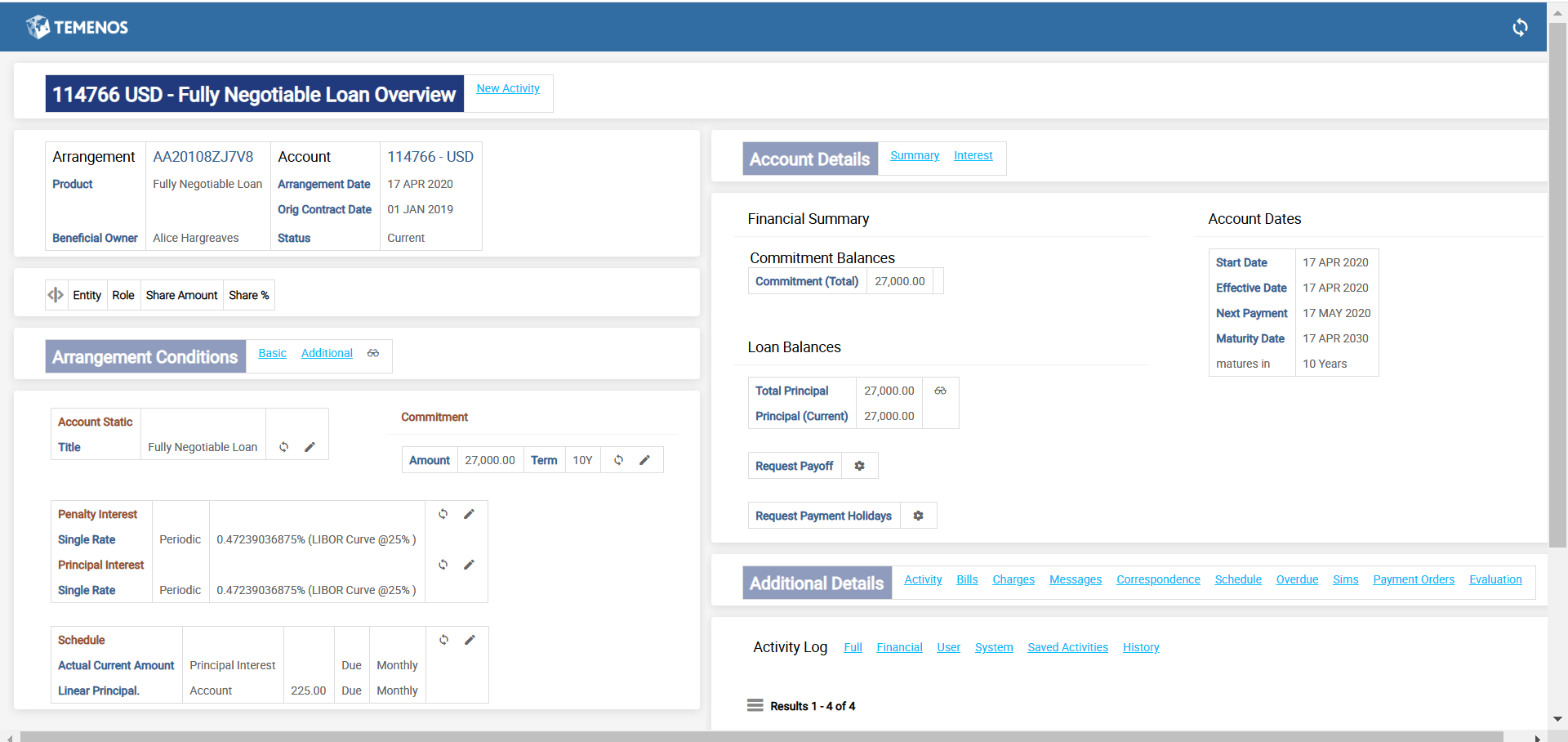
- The TAKEOVER CASHFLOW REPORTING activity is triggered .The Takeover method is “AMC” and EIR is input as 5.
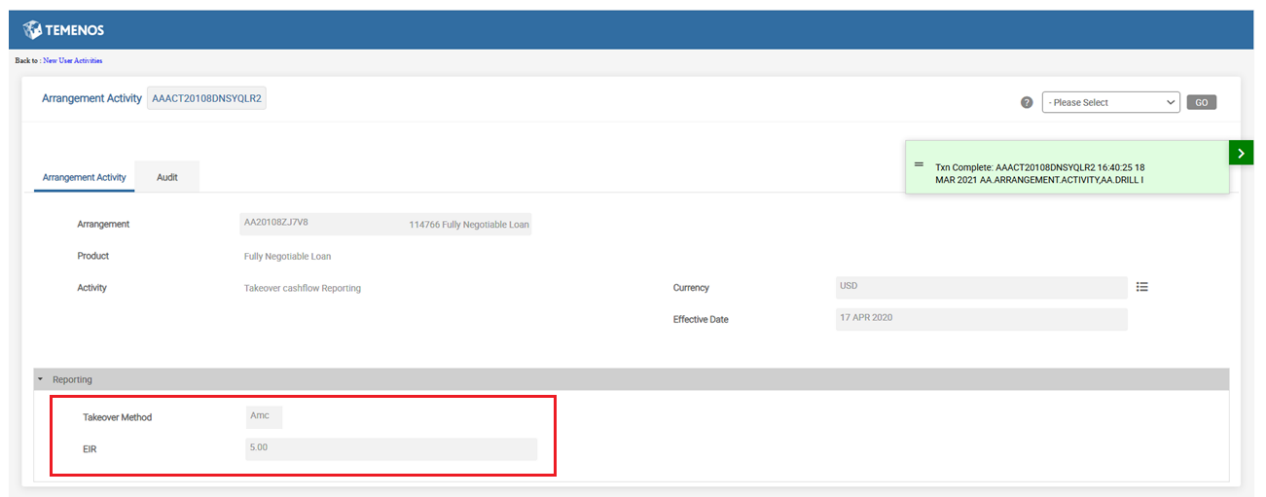
- EB.CASHFLOW is updated with the following details
Event Type updated as TAKEOVER-PERFORMING for the performing loan
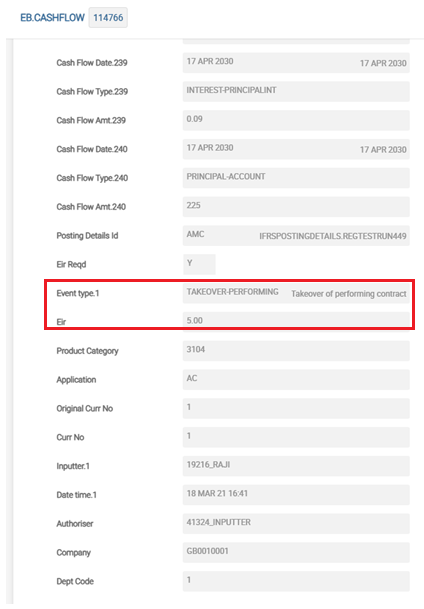
Using EIR Method
- The following screenshot is Lending Arrangement overview after the takeover activity. This loan is in Suspend Status.
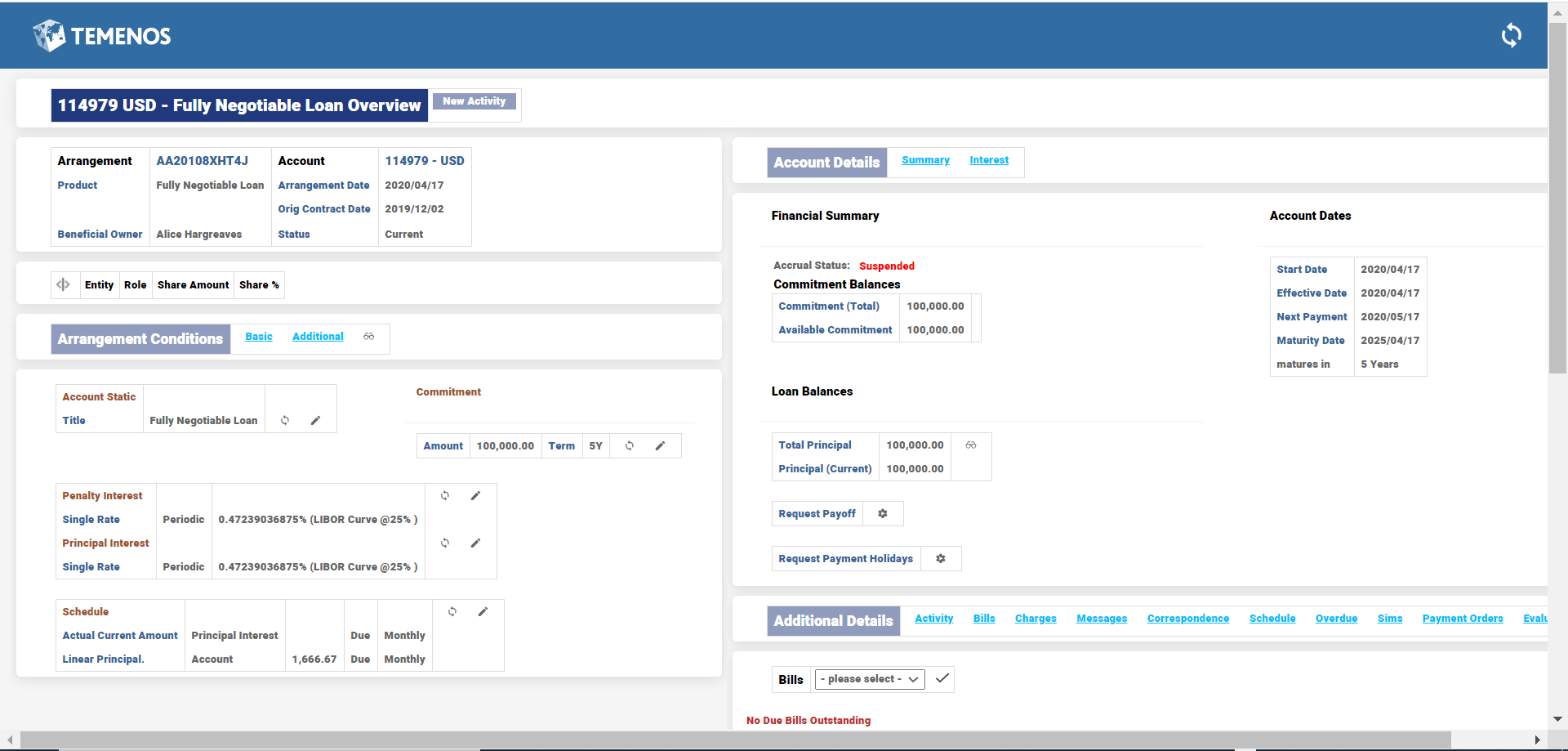
- The TAKEOVER CASHFLOW REPORTING activity is triggered .The Takeover method is “EIR” and AMC is input as 70.
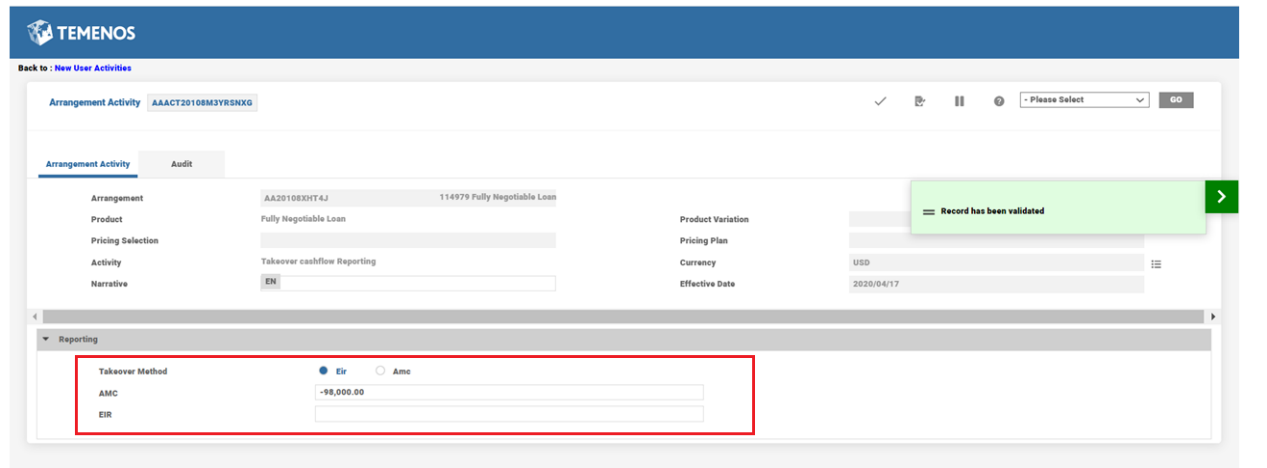
- EB.CASHFLOW is updated with the following details
AMC value is updated in the Takeover Npv field.
Event Type is updated as “TAKEOVER-SUSPEND” for the suspended loan
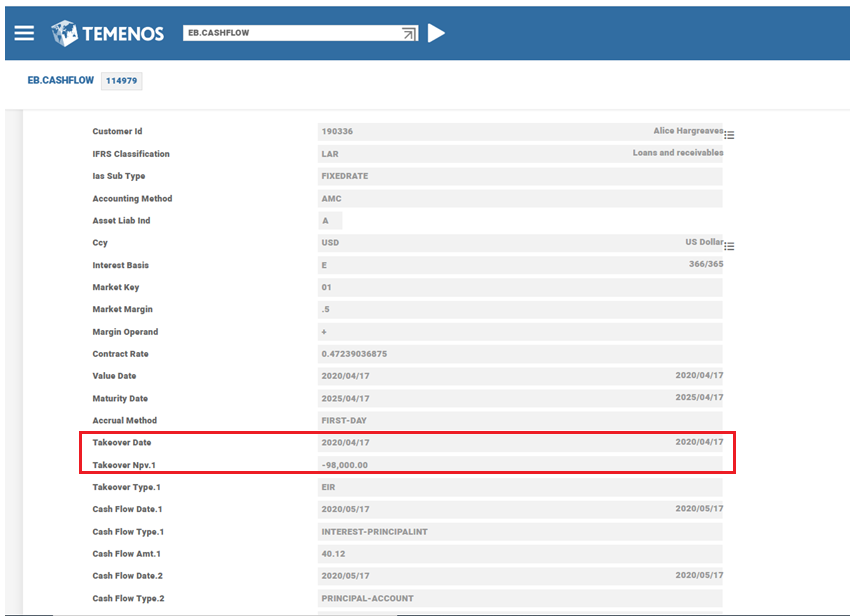
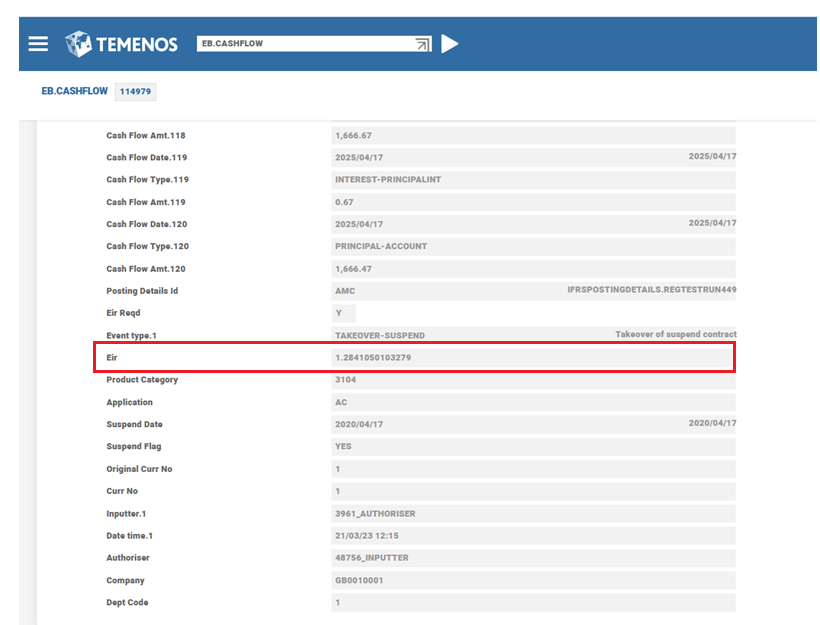
Takeover Sequence
The following section describes the takeover sequence in detail.
Takeover process – AA Contract with Reporting PC (in IFRS standard)
This process is for existing bank with AA loans & IFRS reporting in their system but switching to FASB standards (from IFRS).
- Update Reporting condition for the loan product.
- Proof and Publish the product.
- Trigger IFRS activity.
- Update EIR or AMC as required and commit.
- EB Cashflow gets updated.
Takeover process – AA Contract without Reporting PC (without IFRS standard)
This process is for existing bank with AA loans without IFRS module initially but later comply.
- Add Reporting condition for the loan product.
- Proof and Publish the product.
- Trigger IFRS activity.
- Update EIR or AMC as required and commit.
- EB Cashflow gets updated.
Full Takeover from legacy (Non AA, Non IFRS case)
This process involves migration of loans from legacy system into Temenos' solution with AA & IFRS functionality.
- Create Loan product with Reporting condition
- Complete loan Takeover sequence to migrate the outstanding loan bills and balances.
- Trigger IFRS activity.
- Update EIR or AMC as required and commit.
- EB Cashflow gets updated.
In this topic